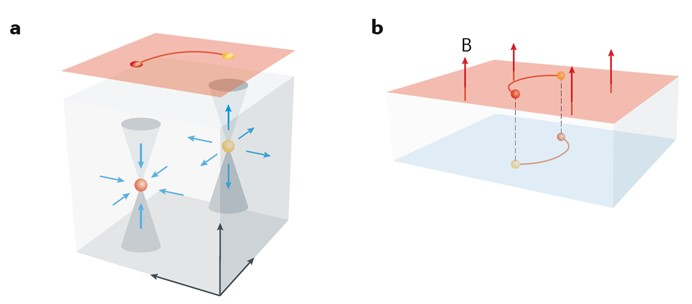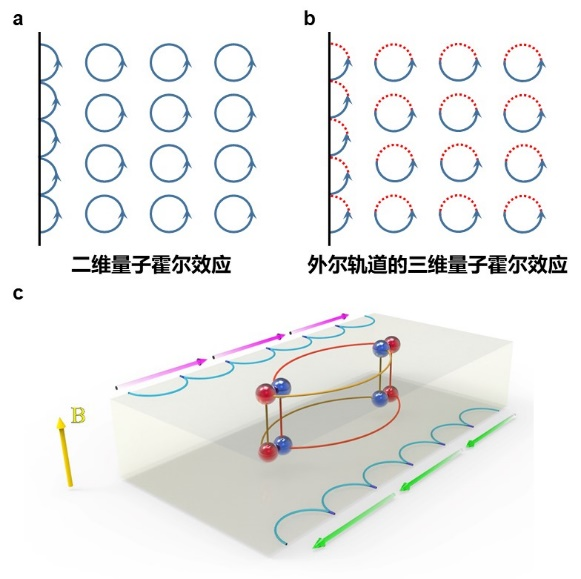Professor Faxian Xiu was invited to write a review paper on the novel Weyl electron cyclotron orbitals in Nature Review Physics. The paper was titled “Cycling Fermi arc electrons with Weyl orbitals” and was published online on July 15, 2021 in Nature Reviews Physics 3, 660 (2021). The corresponding author is Professor Faxian Xiu, and the first author is Cheng Zhang, a teen researcher at the Institute for Nanoelectronic and Quantum computing of Fudan University.
Weyl orbitals are a new type of electron cyclotron orbitals unique to topological semimetals. The conventional electron cyclotron orbit in crystals is a closed curve cyclotron motion of electrons under the action of Lorraine magnetic force in a magnetic field, along the boundary of the Fermi plane perpendicular to the magnetic field in the inverted space. This behavior can lead to a series of important physical phenomena such as Shubnikov de Haas (SdH) quantum oscillation, cyclotron resonance, and quantum Hall effect. In recent years, a new topological electronic material - topological semi metals - proposed by Professor Xiangang Wan and others from Nanjing University has been widely studied by researchers in condensed matter physics. Topological semimetallic states have energy band overlap points, and the corresponding quasi particle excitations can be approximated as massless Fermions. An important characteristic of topological semimetals is the non-closed Fermi arc surface state, where the two endpoints are ultimately connected to the Weyl points of the body state, so under normal circumstances, they do not form a cyclotron orbit. However, if we consider the configuration of thin layer devices, the Fermi arcs on the upper and lower surfaces can couple under a magnetic field to form a closed loop, connecting the chiral energy levels of the body state that also pass through the Wail point, just like constructing a wormhole connecting different surfaces in a crystal, which can allow electrons to freely tunnel.

Figure. (a) Electronic structures of topological semimetallic bulk and surface states. (b) Schematic diagram of Weyl track
This theory was first proposed by Ashvin Vishwanath et al. of Harvard University and first confirmed in 2016 by the James Analytics research group at the University of California, Berkeley through SdH quantum oscillation experiments in cadmium arsenide nanostructures cut by focused ion beams. In 2017, Faxian Xiu’s research group at Fudan University and the Mingliang Tian’s research group at the High Magnetic Field Laboratory of the Chinese Academy of Sciences also observed experimental evidence of Weyl orbitals in directly grown intrinsic cadmium arsenide nanosheets. Faxian Xiu also found that after improving the crystal quality and reducing the concentration of bulk carriers, the quantum oscillations in cadmium arsenide nanosheets will further evolve into the quantum Hall effect, transitioning from semi classical cyclotron motion to the quantum conductivity category of ballistic transport. At the same time, the Haizhou Lu’s research group of Southern University of Science and Technology and the Xincheng Xie’s research group of Peking University have also theoretically pointed out that the Weyl orbit can be seen as a "wormhole" connecting two planes in three-dimensional space, which can serve as a new solution to achieve the quantum Hall effect in three-dimensional systems. These breakthroughs have attracted widespread attention in the field, and multiple laboratories such as the University of Tokyo, the University of California, Santa Barbara, and Peking University have also conducted in-depth research on the quantum Hall effect of cadmium arsenide systems.

Figure. (a) Graphical representation of two-dimensional quantum Hall effect. (b) Graphical representation of three-dimensional quantum Hall effect based on Weyl orbitals. (c) Schematic diagram of three-dimensional quantum Hall cyclotron orbitals and edge states in cadmium arsenide.
In this review paper, the author provides a systematic introduction to the formation mechanism and physical properties of Weyl orbitals, and delves into the influence of Weyl orbitals on material electrical behavior from two aspects: the three-dimensional quantum Hall effect and low scattering probability characteristics. The Weyl orbit introduces the third dimensional non dissipative motion of a parallel magnetic field while ensuring the non-dispersion of the Landau level. This special physical process allows the quantum Hall cyclotron orbit to break through the limitations of two-dimensional space and expand to higher dimensions. Meanwhile, due to its quasi-linear electronic structure, the Fermi arc in the Weyl orbit can effectively suppress the scattering probability between electrons, and can still have high mobility even at high electron density of states. This characteristic provides a feasible approach for materials science to search for high-performance conductors and reduce electron scattering dissipation.
In addition, many novel characteristics and phenomena of the Weyl orbit have also been continuously explored. The team of Professor Hua Jiang from Suzhou University and Professor Xincheng Xie from Peking University presented physical images of quantum Hall boundary states in Weyl orbitals under different crystal orientations and magnetic fields, and proposed the use of tilted magnetic fields to achieve spatial modulation of three-dimensional quantum Hall boundary states. The Ady Stern research group at the Weizmann Institute of Science has found that Weizmann orbitals can be used to induce non local DC and AC voltage responses. The "wormholes" constructed by Weizmann orbitals can be used for specific energy microwave resonance transmission, and can be used in electronic devices such as bandwidth filters. Justin Song and others from Nanyang University of Technology found that a new type of hyperbolic plasmon can be formed based on Fermi arcs. Claudia Felser et al. from the Max Planck Institute in Germany reported the application of the high mobility characteristics of Fermi arcs in hydrogen catalytic reactions, which made topological semimetals a new hydrogen catalytic system. These research ideas and schemes are also continuously expanding the research frontiers of topological semimetals and deepening people's understanding of topological states of matter.
Paper link: https://www.nature.com/articles/s42254-021-00344-z